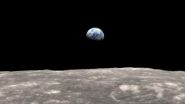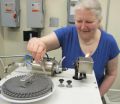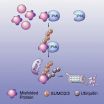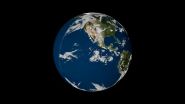(Press-News.org) Scientists combined observations from two NASA missions to check out the moon's lopsided shape and how it changes under Earth's sway – a response not seen from orbit before.
The team drew on studies by NASA's Lunar Reconnaissance Orbiter, which has been investigating the moon since 2009, and by NASA's Gravity Recovery and Interior Laboratory, or GRAIL, mission. Because orbiting spacecraft gathered the data, the scientists were able to take the entire moon into account, not just the side that can be observed from Earth.
"The deformation of the moon due to Earth's pull is very challenging to measure, but learning more about it gives us clues about the interior of the moon," said Erwan Mazarico, a scientist with the Massachusetts Institute of Technology in Cambridge, Mass., who works at NASA's Goddard Space Flight Center in Greenbelt, Md.
The lopsided shape of the moon is one result of its gravitational tug-of-war with Earth. The mutual pulling of the two bodies is powerful enough to stretch them both, so they wind up shaped a little like two eggs with their ends pointing toward one another. On Earth, the tension has an especially strong effect on the oceans, because water moves so freely, and is the driving force behind tides.
Earth's distorting effect on the moon, called the lunar body tide, is more difficult to detect, because the moon is solid except for its small core. Even so, there is enough force to raise a bulge about 20 inches (51 centimeters) high on the near side of the moon and similar one on the far side.
The position of the bulge actually shifts a few inches over time. Although the same side of the moon constantly faces Earth, because of the tilt and shape of the moon's orbit, the side facing Earth appears to wobble. From the moon's viewpoint, Earth doesn't sit motionless but moves around within a small patch of sky. The bulge responds to Earth's movements like a dance partner, following wherever the lead goes.
"If nothing changed on the moon – if there were no lunar body tide or if its tide were completely static – then every time scientists measured the surface height at a particular location, they would get the same value," said Mike Barker, a Sigma Space Corporation scientist based at Goddard and co-author of the new study, which is available online in Geophysical Research Letters.
A few studies of these subtle changes were conducted previously from Earth. But not until LRO and GRAIL did satellites provide enough resolution to see the lunar tide from orbit.
To search for the tide's signature, the scientists turned to data taken by LRO's Lunar Orbiter Laser Altimeter, or LOLA, which is mapping the height of features on the moon's surface. The team chose spots that the spacecraft has passed over more than once, each time approaching along a different flight path. More than 350,000 locations were selected, covering areas on the near and far sides of the moon.
The researchers precisely matched measurements taken at the same spot and calculated whether the height had risen or fallen from one satellite pass to the next; a change indicated a shift in the location of the bulge.
A crucial step in the process was to pinpoint exactly how far above the surface LRO was located for each measurement. To reconstruct the spacecraft's orbit with sufficient accuracy, the researchers needed the detailed map of the moon's gravity field provided by the GRAIL mission.
"This study provides a more direct measurement of the lunar body tide and much more comprehensive coverage than has been achieved before," said John Keller, LRO project scientist at Goddard.
The good news for lunar scientists is that the new results are consistent with earlier findings. The estimated size of the tide confirmed the previous measurement of the bulge. The other value of great interest to researchers is the overall stiffness of the moon, known as the Love number h2, and this was also similar to prior results.
Having confirmation of the previous values – with significantly smaller errors than before – will make the lunar body tide a more useful piece of information for scientists.
"This research shows the power of bringing together the capabilities of two missions. The extraction of the tide from the LOLA data would have been impossible without the gravity model of the moon provided by the GRAIL mission," said David Smith, the principal investigator for LRO's LOLA instrument and the deputy principal investigator for the GRAIL mission. Smith is affiliated with Goddard and the Massachusetts Institute of Technology.
LRO is managed by Goddard for the Science Mission Directorate (SMD) at NASA Headquarters in Washington. NASA's Jet Propulsion Laboratory in Pasadena, Calif., managed the GRAIL mission for SMD.
INFORMATION:
For more information about LRO, visit:
http://www.nasa.gov/lro
NASA missions let scientists see moon's dancing tide from orbit
2014-05-29
ELSE PRESS RELEASES FROM THIS DATE:
UNL team explores new approach to HIV vaccine
2014-05-29
Lincoln, Neb., May 29, 2014 -- Using a genetically modified form of the HIV virus, a team of University of Nebraska-Lincoln scientists has developed a promising new approach that could someday lead to a more effective HIV vaccine.
The team, led by chemist Jiantao Guo, virologist Qingsheng Li and synthetic biologist Wei Niu, has successfully tested the novel approach for vaccine development in vitro and has published findings in the international edition of the German journal Angewandte Chemie.
With the new approach, the UNL team is able to use an attenuated -- or weakened ...
A tool to better screen and treat aneurysm patients
2014-05-29
New research by an international consortium, including a researcher from Lawrence Livermore National Laboratory, may help physicians better understand the chronological development of a brain aneurysm.
Using radiocarbon dating to date samples of ruptured and unruptured cerebral aneurysm (CA) tissue, the team, led by neurosurgeon Nima Etminan, found that the main structural constituent and protein – collagen type I – in cerebral aneurysms is distinctly younger than once thought.
The new research helps identify patients more likely to suffer from an aneurysm and embark ...
Gender stereotypes keep women in the out-group
2014-05-29
New Rochelle, NY, May 29, 2014—Women have accounted for half the students in U.S. medical schools for nearly two decades, but as professors, deans, and department chairs in medical schools their numbers still lag far behind those of men. Why long-held gender stereotypes are keeping women from achieving career advancement in academic medicine and what can be done to change the institutional culture are explored in an article in Journal of Women's Health, a peer-reviewed publication from Mary Ann Liebert, Inc., publishers. The article is available free on the Journal of Women's ...
Caught by a hair
2014-05-29
Crime fighters could have a new tool at their disposal following promising research by Queen's professor Diane Beauchemin.
Dr. Beauchemin (Chemistry) and student Lily Huang (MSc'15) have developed a cutting-edge technique to identify human hair. Their test is quicker than DNA analysis techniques currently used by law enforcement. Early sample testing at Queen's produced a 100 per cent success rate.
"My first paper and foray into forensic chemistry was developing a method of identifying paint that could help solve hit and run cases," explains Dr. Beauchemin. "Last year, ...
Neural transplant reduces absence epilepsy seizures in mice
2014-05-29
New research from North Carolina State University pinpoints the areas of the cerebral cortex that are affected in mice with absence epilepsy and shows that transplanting embryonic neural cells into these areas can alleviate symptoms of the disease by reducing seizure activity. The work may help identify the areas of the human brain affected in absence epilepsy and lead to new therapies for sufferers.
Absence epilepsy primarily affects children. These seizures differ from "clonic-tonic" seizures in that they don't cause muscle spasms; rather, patients "zone out" or stare ...
Drop in global malnutrition depends on ag productivity, climate change
2014-05-29
WEST LAFAYETTE, Ind. - Global malnutrition could fall 84 percent by the year 2050 as incomes in developing countries grow - but only if agricultural productivity continues to improve and climate change does not severely damage agriculture, Purdue University researchers say.
"The prevalence and severity of global malnutrition could drop significantly by 2050, particularly in the poorest regions of the world," said Thomas Hertel, Distinguished Professor of Agricultural Economics. "But if productivity does not grow, global malnutrition will worsen even if incomes increase. ...
Penn study shows how misfolded proteins are selected for disposal
2014-05-29
PHILADELPHIA – It's almost axiomatic that misfolded proteins compromise how cells normally function and cause debilitating human disease, but how these proteins are detected and degraded within the body is not well understood. Neurodegenerative diseases – including Alzheimer's disease, Parkinson's disease, amyotrophic lateral sclerosis (Lou Gehrig's disease), Huntington's disease, and spinocerebellar ataxias – exact a devastating toll on aging populations throughout the world.
"Yet, there is virtually no cure for any of these diseases, and clinical trials have yielded ...
Tropical Storm Amanda gets bisected and animated by NASA's CloudSat
2014-05-29
VIDEO:
This animation shows how Cloudsat was able to get the image shown.
Click here for more information.
Tropical Storm Amanda continues to weaken in the eastern Pacific from dry air and wind shear. NASA's CloudSat satellite captured a view of the storm from the side revealing heavy precipitation when the storm was the most powerful May Eastern Pacific on record.
NASA's CloudSat satellite flew over Hurricane Amanda in the east Pacific on May 25, 2014 at 2100 UTC (5 p.m. EDT) ...
An ecological risk research agenda for synthetic biology
2014-05-29
Washington — Environmental scientists and synthetic biologists have for the first time developed a set of key research areas to study the potential ecological impacts of synthetic biology, a field that could push beyond incremental changes to create organisms that transcend common evolutionary pathways.
The Synthetic Biology Project at the Wilson Center and the Program on Emerging Technologies at the Massachusetts Institute of Technology convened the interdisciplinary group of scientists and are releasing the report, Creating a Research Agenda for the Ecological Implications ...
Engineering a better way to rebuild bone inside the body
2014-05-29
Traumatic bone injuries such as blast wounds are often so severe that the body can't effectively repair the damage on its own. To aid the recovery, clinicians inject patients with proteins called growth factors. The treatment is costly, requiring large amounts of expensive growth factors. The growth factors also disperse, creating unwanted bone formation in the area around the injury.
A new technology under development at the Georgia Institute of Technology could one day provide more efficient delivery of the bone regenerating growth factors with greater accuracy and ...






